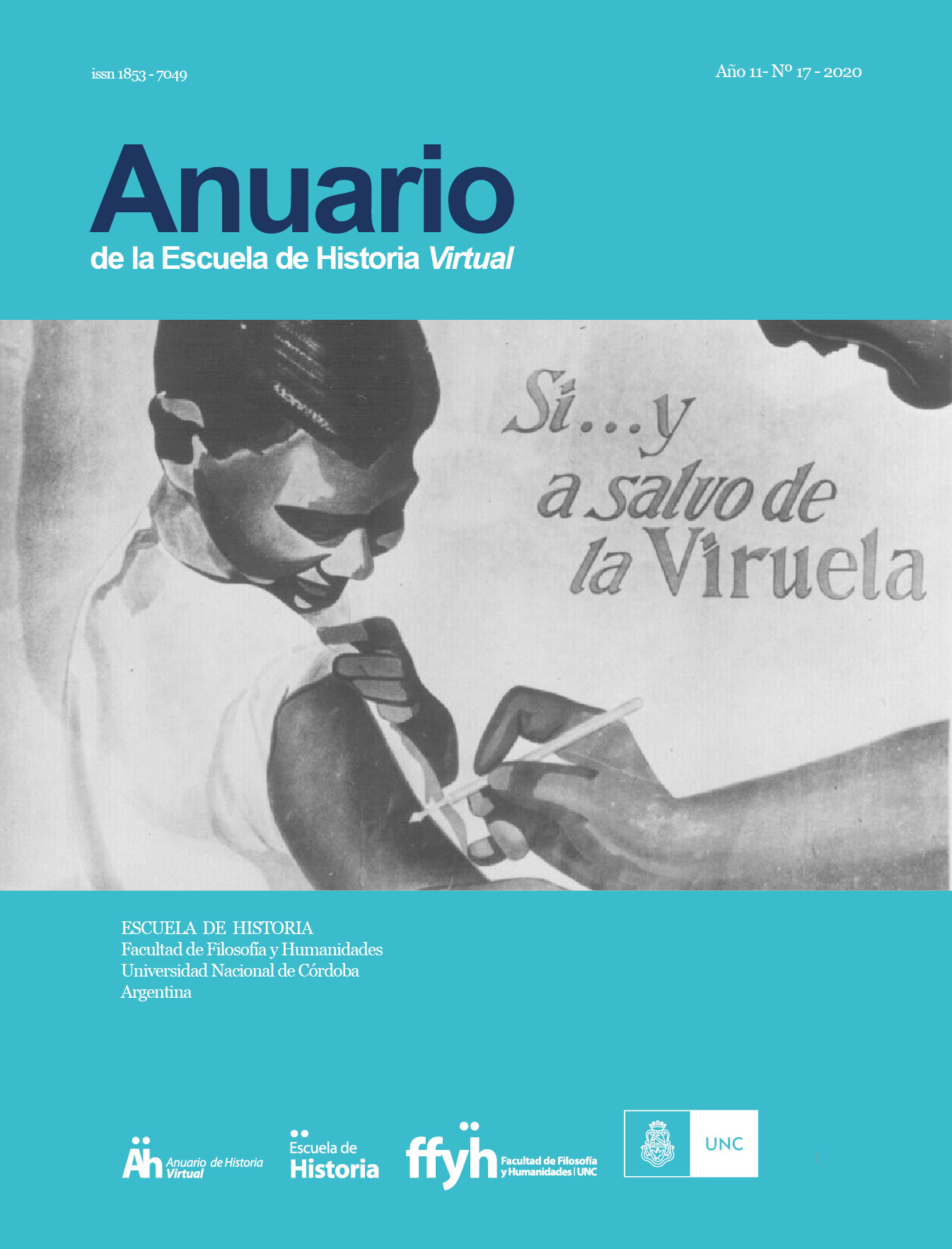So far, so close: Public reception and political uses of the Katyn massacre in Argentina (1943)
Main Article Content
Abstract
In 1940 21,000 Polish intellectuals and officers were shot by the USSR in the Katyn forest. The massacre was hidden by the Russian government and discovered by the Germans in 1943, who used it for propaganda purposes. At the same time, the Soviet Union held the SS responsible for it, involving allied countries in its favor. The article´s purpose is to contribute to Argentina´s political and diplomatic history. To accomplish this aim, the public reception of the massacre is linked to the Country´s foreign policy statements, and how these statements were used by the different internal political actors. The first section presents the Roberto Ortiz (1938-1942) and Ramón Castillo (1942-1943) governments foreign policy’s, and its relationship to the reports of the Argentine consuls in Europe about the Polish officers´ mass graves´ discovery. In the second section, the repercussions in the Argentine public opinion of Katyn's findings are analyzed, interpreting them according to the different alignments of the local political field against the neutral position of the Argentine government in relation to the war and the domestic political reconfigurations.
Downloads
Article Details

This work is licensed under a Creative Commons Attribution-NonCommercial-NoDerivatives 4.0 International License.
Bajo los siguientes términos:
Atribución - Usted debe dar el crédito apropiado, proporcionar un enlace a la licencia e indicar si se hicieron cambios. Usted puede hacerlo de cualquier manera razonable, pero no de ninguna manera que sugiera que el licenciante lo respalda a usted o a su uso.
No comercial - Usted no puede utilizar el material con fines comerciales.
NoDerivados - Si remezclas, transformas o construyes sobre el material, no puedes distribuir el material modificado.
References
(AMRECIyC), Archivo Ministerio de Relaciones Exteriores, Comercio Internacional y Culto, Argentina.
Bisso, A. (2007). Voceros de Hitler en Argentina. Índice, Revista de Ciencias Sociales, vol. 37, (25), 247-280.
Buchrucker, C. (1987). Nacionalismo y peronismo. La Argentina en la crisis ideológica mundial (1927-1955). Buenos Aires: Sudamericana.
Cienciala, A., Materski, W. y Lebedeva, N. (2008). Katyn: A Crime Without Punishment. New Haven: Yale University Press.
Cisek, J. (2011). Post-1991 Katyn Investigations in Poland. Case W. Res. J. Int'l L., vol. 44, 591- 615.
Czapski, J. (2008). En tierra inhumana. Barcelona: Acantilado.
Devoto, F. (2014). Para una reflexión en torno al golpe del 4 de junio de 1943. Estudios Sociales, vol. 46 (1), 171-186.
Drozdzewski, D. (2012). Knowing (or not) about Katyń: the silencing and surfacing of public memory. Space and Polity, vol. 16 (3), 303-319.
Etkind, A. (2013). Remembering Katyn. Cambridge: Polity Press.
Feklyunina, V. (2012). Russia's foreign policy towards Poland: Seeking reconciliation? A social constructivist analysis. International Politics, vol. 49 (4), 434-448.
Kraselsky, J. y Bisso, A. (2003). La hermandad aislada. La conflictiva neutralidad argentino-chilena durante la segunda guerra mundial. De Pearl Harbor y la conferencia de Río de Janeiro a la ruptura de relaciones de Argentina con el Eje (Diciembre 1941-Enero 1944). Revista de Estudios Trasandinos, (8 y 9), 109-121.
Lvovich, D. (2003). Nacionalismo y antisemitismo en la Argentina. Buenos Aires: Ediciones B.
Maciejczak, Z. (2018). Pamiec o zbrodni katynskiey w polsce. Warszawa: Ministerstwo Kultury i Dziedzictwa Narodowego.
Mackiewicz, J. (2016). La masacre del bosque de Katyn. Crimen sin juicio ni sentencia. Buenos Aires: Ediciones Sieghels.
Morgenfeld, L. (2009). La neutralidad argentina y el sistema interamericano: Panamá, La Habana y Río de Janeiro (1939-1942). Ciclos, vol. XVIII (35), 145-172.
Muzeum Katiñskie (2017). Korespondencja wydobyta z dolów smierci Charkowa i Miednoje. Warszawa.
NKHBZK (Niezależny Komitet Historyczny Badania Zbrodni Katyńskiej) (2005). Zbrodnia Katyńska. Polskie sledztwo. Warszawa.
Otero, H. (2009). La guerra en la sangre. Los franco-argentinos ante la Primera Guerra Mundial. Buenos Aires: Sudamericana.
Paul, A. (1991). Katyn: The Untold Story of Stalin's Polish Massacre. London: Scribner Book Company.
Przewoznik, A. y Adamska, J. (2011). Zbrodnia katyńska: mord, kłamstwo, pamięć. Warszawa: Wydawn Literackje.
Rapoport, M. (1995). Argentina y la Segunda Guerra Mundial: mitos y realidades. Estudios Interdisciplinarios de América Latina y el Caribe, vol. 6 (1), 73-95.
Raszeja, S. y Chroscielewski, E. (1994). Medicolegal reconstruction of the Katyń forest massacre. Forensic science international, vol. 68 (1), 1-6.
Rubinzal, M. (2008a). Los conflictos obreros en la prensa nacionalista: itinerarios de un acercamiento ambiguo al mundo del trabajo (1935-1943). Papeles de trabajo. Revista electrónica del Instituto de Altos Estudios Sociales de la Universidad Nacional de General San Martín, vol. 2 (3), s/p.
Rubinzal, M. (2008b). La disputa en las plazas: estrategias, símbolos y rituales del primero de mayo nacionalista (Buenos Aires, 1930-1943). Historia y Política, (19), 255-285.
Sanford, G. (2007). Katyn and the Soviet Massacre of 1940: Truth, Justice and Memory. London: Routledge.
Senkman, L. (1995). El nacionalismo y el campo liberal argentinos ante el neutralismo 1939- 1943. Estudios Interdisciplinarios de América Latina y el Caribe, vol. 6 (1), 60-72.
Sterio, M. (2011). Katyn forest massacre: of genocide, state lies, and secrecy. Case W. Res. J. Int'l L., (44), 615-630.
Szymczak, R. (2008). The vindication of memory: The Katyn case in the West, Poland, and Russia, 1952-2008. The Polish Review, vol. 53 (4), 419-443.
Tarczyński, M. (2008). Zbrodnia katyńska między prawdą i kłamstwem. Warszawa: Niezależny Komitet Historyczny Badania Zbrodni Katyńskiej.
Tato, M. I. y Romero, L. A. (2003). La prensa periódica argentina y el régimen nazi. En I. Klich (Comp.), Sobre nazis y nazismo en la cultura argentina (pp. 157-176). Buenos Aires: Universidad of Maryland/Hispamérica.
Tato, M. I. (2007). El ejemplo alemán. La prensa nacionalista y el Tercer Reich. Escuela de Historia, vol. 1 (6), 21-45.
Weber, C. (2015). Krieg der Täter: Die Massenerschießungen von Katyn. Berlin: Gebundenes Buch.
